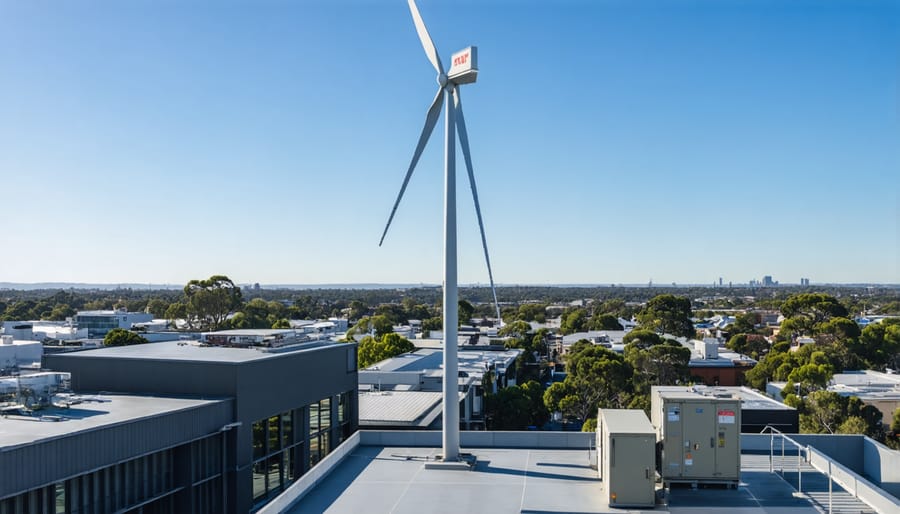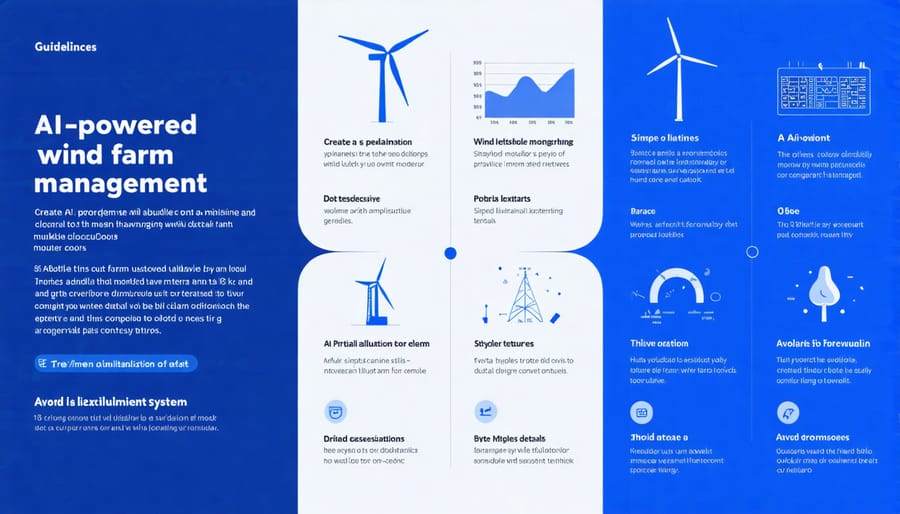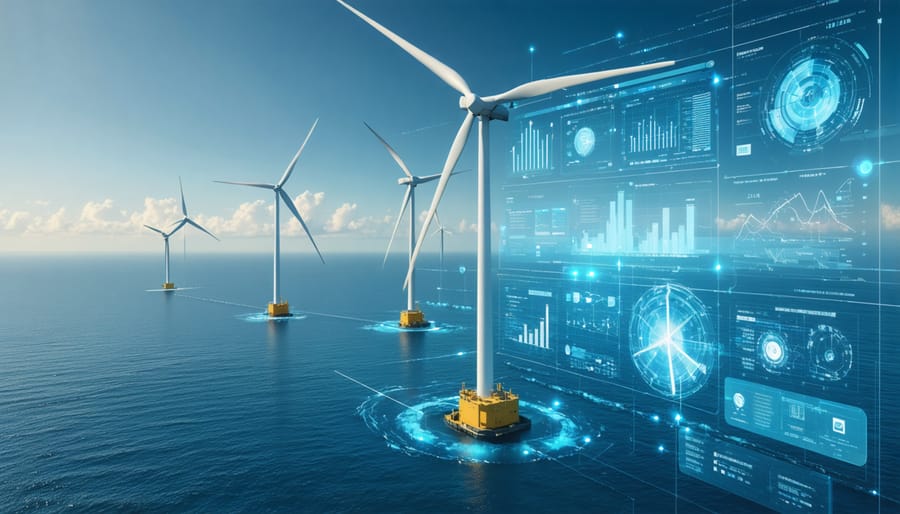Wind energy stands at the cutting edge of renewable energy solutions, transforming how Australia powers its future. Revolutionary floating wind turbines now capture powerful offshore winds previously beyond reach, while breakthrough blade designs inspired by humpback whale flippers increase energy generation by up to 35%. These innovations arrive at a crucial moment, as Australia’s windswept coastlines and vast outback hold enough wind potential to power the entire continent several times over.
From microscale vertical turbines revolutionizing urban power generation to AI-driven smart wind farms that adjust in real-time to weather patterns, today’s wind energy technologies are shattering efficiency barriers. These advancements don’t just generate clean power—they create jobs, strengthen energy independence, and accelerate Australia’s transition to a sustainable future. As costs plummet and capabilities soar, innovative wind energy solutions are proving that the path to clean, reliable power is not just possible—it’s already here.
Game-Changing Wind Turbine Designs
Vertical Axis Innovation
Urban environments are witnessing a quiet revolution in wind energy with the emergence of innovative vertical axis wind turbines (VAWTs). Unlike their traditional counterparts, these sleek, cylindrical structures rotate around a vertical shaft, making them perfectly suited for city rooftops and tight spaces.
Australian cities like Melbourne and Sydney are increasingly adopting these modern marvels, which can harness wind from any direction without needing to reorient themselves. The compact design means they can be installed in places where conventional turbines simply wouldn’t fit, from apartment buildings to shopping centres.
One standout innovation is the helix-shaped VAWT, which operates nearly silently – a game-changer for urban applications. These turbines can start generating power in wind speeds as low as 2 metres per second, making them effective even in areas with moderate wind conditions.
Recent developments in materials science have led to lighter, more durable VAWTs that are both cost-effective and low-maintenance. Some models now incorporate smart sensors that adjust blade angles for optimal performance, while others feature innovative magnetic levitation systems that reduce friction and wear.
Local success stories include the Brunswick East community wind project, where rooftop VAWTs power common areas in residential buildings, and the Adelaide Central Market’s installation, which combines solar panels with vertical axis turbines in a hybrid energy solution. These examples demonstrate how vertical axis innovation is making wind power accessible to urban Australia, one rooftop at a time.

Small-Scale Solutions
Small-scale wind energy solutions are revolutionising how Australians power their homes and small businesses. These compact turbines, often no taller than a typical garden tree, are designed to harness wind energy in urban and suburban environments where space is at a premium.
Leading the charge are vertical-axis wind turbines (VAWTs), which operate effectively in variable wind conditions common to Australian cities. Unlike their larger counterparts, these innovative designs can generate power from wind coming from any direction, making them ideal for rooftop installation. A single compact turbine can generate between 1-5 kW, enough to offset a significant portion of a household’s energy consumption.
Local success stories include the Brisbane café that reduced its energy bills by 40% using a rooftop VAWT system, and the Melbourne suburban home that combines small wind turbines with solar panels to achieve near-complete energy independence. These systems are particularly effective in coastal areas, where steady sea breezes provide reliable power generation.
Recent technological improvements have addressed traditional concerns about noise and vibration, with new models operating at whisper-quiet levels. Many systems now come with smart monitoring capabilities, allowing owners to track power generation through their smartphones and optimise performance based on local weather patterns.
For small businesses and homeowners looking to reduce their carbon footprint while cutting energy costs, these small-scale solutions offer a practical entry point into wind energy generation.
Smart Integration Technologies
AI-Powered Wind Forecasting
In the ever-evolving landscape of wind energy, artificial intelligence is revolutionizing how we harness the power of the wind. Australian wind farms are increasingly adopting sophisticated AI systems that can predict wind patterns with unprecedented accuracy, leading to optimized turbine performance and increased energy yields.
These smart systems analyze vast amounts of data from multiple sources, including weather stations, satellite imagery, and historical wind patterns. By processing this information in real-time, AI algorithms can adjust turbine blade angles and rotation speeds to maximize energy capture in varying conditions. This technology works seamlessly with modern energy storage technology to ensure consistent power supply, even during fluctuating wind conditions.
The implementation of AI-powered forecasting has shown remarkable results across Australian wind farms. For instance, the Lake Bonney Wind Farm in South Australia reported a 15% increase in energy production after implementing AI prediction systems. These smart solutions can forecast wind conditions up to seven days in advance with 90% accuracy, allowing operators to better plan and optimize their operations.
Beyond simple prediction, machine learning algorithms are now capable of detecting potential maintenance issues before they occur, reducing downtime and extending turbine life spans. This predictive maintenance approach has helped wind farms across the country slash operational costs while maintaining peak performance.
For farm operators and energy providers, this means more reliable power generation and better integration with the national grid. Communities benefit from more stable renewable energy supply, while investors see improved returns through enhanced operational efficiency. It’s a win-win situation that’s helping drive Australia’s transition to clean energy.

Hybrid Energy Systems
The future of wind energy lies in its seamless integration with other renewable sources, creating robust and reliable power systems that work around the clock. These hybrid systems combine wind turbines with solar power integration and innovative energy storage solutions to overcome the intermittent nature of individual renewable sources.
In Australia, hybrid energy systems are proving particularly effective in remote communities and mining operations. For example, the Kennedy Energy Park in North Queensland combines wind turbines with solar panels and battery storage, providing a blueprint for future energy installations. This combination ensures power generation continues during nighttime when solar panels are inactive and during cloudy days when wind power can pick up the slack.
The beauty of hybrid systems lies in their flexibility and adaptability. When strong winds blow during peak sunlight hours, excess energy can be stored for later use. This intelligent energy management not only maximises efficiency but also reduces the need for backup fossil fuel generators, leading to significant cost savings and environmental benefits.
Modern hybrid installations use smart grid technology to automatically switch between different energy sources, ensuring optimal performance and reliability. These systems can predict weather patterns and adjust their operation accordingly, making them increasingly attractive to both utility companies and private enterprises looking to achieve energy independence while reducing their carbon footprint.
Real Cost Benefits
Energy Bill Reduction
Australian households and businesses are reaping significant financial rewards from wind energy adoption, with remarkable success stories emerging across the country. The Thompson family in South Australia saw their quarterly energy bills drop by 65% after connecting to a local wind farm cooperative, saving over $2,400 annually. Their experience isn’t unique – similar households participating in wind energy programs report average savings between $1,800 and $3,000 per year.
In the business sector, the results are even more impressive. The Riverdale Shopping Centre in Victoria slashed its energy costs by 78% after installing on-site wind turbines and joining a renewable energy purchase agreement. Small businesses participating in community wind projects have reported average savings of $8,000 to $12,000 annually, while larger industrial operations are seeing reductions of up to $150,000 per year.
Rural communities have emerged as major beneficiaries, with farming operations utilizing wind energy reporting energy cost reductions of 50-70%. The Mitchell Dairy Farm in Tasmania now saves $45,000 annually after transitioning to wind power, while simultaneously reducing their carbon footprint.
These savings aren’t just immediate – they’re increasing over time as technology improves and installation costs decrease. With new government incentives and improved storage solutions, experts predict household savings could increase by an additional 30% over the next five years.

Government Incentives
Australia offers numerous incentives to accelerate wind energy adoption, making it an increasingly attractive investment for businesses and communities alike. The federal government’s Renewable Energy Target (RET) scheme remains one of the most significant drivers, providing certificates for every megawatt-hour of renewable energy generated.
State governments have also stepped up with their own support mechanisms. Victoria’s Renewable Energy Target (VRET) and New South Wales’ Renewable Energy Zones (REZs) provide substantial backing for new wind projects. These initiatives include streamlined approval processes, grid connection support, and financial incentives for developers.
For small-scale installations, the Small-scale Renewable Energy Scheme (SRES) offers upfront rebates through small-scale technology certificates (STCs). Rural communities can access additional funding through the Regional and Remote Communities Reliability Fund, which supports innovative wind energy solutions in isolated areas.
Business owners can benefit from instant asset write-offs and accelerated depreciation for wind energy installations. Local councils often provide rate reductions and planning assistance for properties incorporating wind energy systems.
The Clean Energy Finance Corporation (CEFC) offers competitive financing options, including low-interest loans for large-scale wind projects. Additionally, the Australian Renewable Energy Agency (ARENA) provides grants for innovative wind energy technologies and integration solutions.
These incentives have helped Australia become a leading wind energy producer, with support continuing to evolve as technology advances and installation costs decrease.
Environmental Impact
The environmental benefits of innovative wind energy technologies extend far beyond simply reducing carbon emissions. These cutting-edge solutions are transforming Australia’s renewable energy landscape while protecting our unique ecosystems. Modern wind turbines now incorporate wildlife-friendly designs that significantly reduce bird and bat collisions, with some models featuring specialized radar systems that can detect approaching wildlife and adjust operation accordingly.
Recent innovations in blade design have not only improved efficiency but also decreased noise pollution, addressing one of the traditional concerns about wind farms. The latest ultra-quiet turbines operate at sound levels comparable to everyday background noise, making them more compatible with both urban and rural environments.
In the Australian context, new wind technologies are proving particularly valuable for land conservation. Unlike traditional power plants, wind farms allow for dual land use, enabling farmers to continue grazing livestock or growing crops around the turbines. This approach has been especially successful in regions like South Australia and Victoria, where wind farms have become an additional income stream for farmers while maintaining agricultural productivity.
The environmental footprint of wind turbine manufacturing has also seen remarkable improvements. Advanced materials and manufacturing processes have reduced the resources needed to produce turbines, while increasing their lifespan and recyclability. Many components are now designed for easy disassembly and reuse, supporting circular economy principles.
Perhaps most impressively, modern wind farms are contributing to biodiversity conservation. Some offshore wind installations create artificial reefs, providing new habitats for marine life. On land, thoughtfully planned wind farms can actually enhance local ecosystems through careful vegetation management and habitat corridors.
Water conservation is another significant benefit, as wind energy requires virtually no water for operation – a crucial advantage in Australia’s drought-prone climate. This stands in stark contrast to conventional power generation methods, which typically consume vast amounts of water for cooling.
As Australia stands at the forefront of renewable energy innovation, the future of wind power looks increasingly promising. Our nation’s vast windswept coastlines and open plains present unprecedented opportunities for harnessing wind energy in smarter, more efficient ways. The emerging technologies we’ve explored – from floating offshore turbines to AI-powered grid management systems – are set to transform our renewable energy landscape.
Australian innovators and research institutions continue to push boundaries, developing solutions that could make wind power more accessible and reliable than ever before. The integration of advanced materials, smart sensors, and predictive maintenance systems is reducing operational costs while increasing energy output, making wind power increasingly competitive with traditional energy sources.
Looking ahead, we can expect to see more hybrid wind farms combining multiple renewable technologies, enhanced storage solutions, and improved grid integration systems. These innovations will not only power our homes and businesses but also create thousands of green jobs and stimulate regional economies across the country.
The path forward is clear: Australia has the potential to become a global leader in wind energy innovation. By embracing these technological advances and continuing to invest in research and development, we’re not just creating a more sustainable future – we’re building a stronger, more resilient energy infrastructure for generations to come. The winds of change are blowing, and Australia is perfectly positioned to harness their power.

